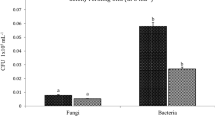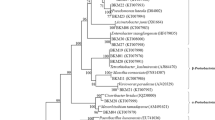Abstract
Present study was designed to determine the microbial diversity from three distinctive sites (amended with vermicompost) of Gujarat, India. A set of 76 strains were screened from total of 438 strains that exhibit plant growthpromoting (PGP) and antagonistic potential isolated from sites PS1 (Mehsana district), BS2 (Dantiwada district) and VS3 (Gandhinagar district). Their diversity indices were studied for determining the species richness and evenness of screened isolates. Results revealed that site BS2 showed the most significant diversity indices in terms of Shannon (H′ 1.525) and Simpson (1/D 5.120) than other two samples. Principal component analysis showed that bacterial diversity (H′) was correlated with the soil characteristics. Chickpea and groundnut plants inoculated with MBCU1 and MBCU3 isolates showed an increase in the vegetative growth parameters that evaluate plant growth when compared to uninoculated controls. Strains MBCU1 and MBCU3 were identified as Pseudomonas stutzeri and Pseudomonas mosselii, respectively, according to sequence analysis of the 16S rRNA gene. These both isolates belong to site BS2 and they showed specific PGP traits suggesting that these isolates can promote plant growth by more than one mechanism with respect to their higher diversity index.
Similar content being viewed by others
Abbreviations
- PCA:
-
principal component analysis
- PGP:
-
plant growth-promoting
- PGPR:
-
plant growth-promoting rhizobacteria
- PIE:
-
probability of an interspecific encounter
References
Arruda L., Beneduzi A., Martins A., Lisboa B., Lopes C., Bertolo F., Passaglia L.M.P. & Vargas L.K. 2013. Screening of rhizobacteria isolated from maize (Zea mays L.) in Rio Grande do Sul State (South Brazil) and analysis of their potential to improve plant growth. Appl. Soil Ecol. 63: 15–22.
Bashan Y., Puente M.E., Rodriguez-Mendoza M.N., Toledo G., Holguin G., Ferrera-Cerrato R. & Pedrin S. 1995. Survival of Azospirillum brasilense in the bulk soil and rhizosphere of soil types. Appl. Environ. Microbiol. 61: 1938–1945.
Bhatia S., Maheshwari D.K., Dubey R.C., Arora D.S., Bajpai V.K. & Kang S.C. 2008. Beneficial effects of fluorescent pseudomonads on seed germination, growth promotion, and suppression of charcoal rot in groundnut (Arachis hypogea L). J. Microbiol. Biotechnol. 18: 1578–1583.
Berger W.H. & Parker F.L. 1970. Diversity of planktonic forminifera in deep-sea sediments. Science 168: 1345–1347.
Beneduzi A., Moreira F., Costa P.B., Vargas L.K., Lisboa B.B., Favreto R., Baldani J.I. & Passaglia L.M.P. 2013. Diversity and plant growth promoting evaluation abilities of bacteria isolated from sugarcane cultivated in the South of Brazil. Appl. Soil Ecol. 63: 94–104.
Castric P.A. 1975. Hydrogen cyanide; a secondary metabolite of Pseudomonas aeruginosa. Can. J. Microbiol. 21: 613–618.
Cattelan A.Z., Hartal P.G. & Fuhrmann J.J. 1990. Screening for plant growth promoting rhizobacteria to promote early soybean growth. Soil Sci. Soc. Am. J. 43: 1670–1680.
Doan T.T., Ngo P.T., Rumpel C., Bo Van Nguyene B.V. & Jouquet P. 2013. Interactions between compost, vermicompost and earthworm influence plant growth and yield: a one-year greenhouse experiment. Sci. Horticult. 160: 148–154.
Edwards C.A. 1998. The use of earthworms in the breakdown and management of organic wastes, pp. 327–354. In: Edwards C.A. (ed.), Earthworm Ecology. CRC Press, Boca Raton.
Edwards C.A. & Bohlen P.J. 1996. Biology and Ecology of Earthworms. Chapman and Hall, London, 426 pp.
Gaur A.C. 1990. Phosphate Solubilizing Micro-organisms as Biofertilizer. Omega Scientific Publishers, New Delhi, 176 pp.
Gopalakrishnan S., Humayun P., Kiran B.K., Kannan I.G.K., Vidya M.S., Deepthi K. & Rupela O. 2011. Evaluation of bacteria isolated from rice rhizosphere for biological control of charcoal rot of sorghum caused by Macrophomina phaseolina (Tassi) Goid. World J. Microbiol. Biotechnol. 27: 1313–1321.
Gupta C.P., Kumar C.P., Dubey R.C. & Maheshwari D.K. 2002. Plant growth enhancement and suppression of Macrophomina phaseolina causing charcoal rot of peanut by fluorescent Pseudomonas. Biol. Fertil. Soils 35: 399–405.
Hurlbert S.H. 1971. The nonconcept of species diversity: a critique and alternative parameters. Ecology 52: 577–586.
Jha C. K., Patel D., Rajendran N. & Saraf M. 2010. Combinatorial assessment on dominance and informative diversity of PGPR from rhizosphere of Jatropha curcas L. J. Basic Microbiol. 50: 211–217.
Jha C.K. & Saraf M. 2011. In vitro evaluation of indigenous plant growth promoting rhizobacteria isolated from Jatropha curcas rhizosphere. Int. J. Gene Eng. Biotechnol. 2: 91–100.
Kaiser M.J., Ramsay K., Richardson C.A., Spence F.E. & Brand A.R. 2000. Chronic fishing disturbance has changed shelf sea benthic community structure. J. Anim. Ecol. 69: 494–503.
Kemmitt S.J., Wright D., Goulding K.W.T. & Jones D.L. 2006. pH regulation of carbon and nitrogen dynamics in two agricultural soils. Soil Biol. Biochem. 38: 898–911.
Kishore G.K., Pande S. & Podile A.R. 2005. Phylloplane bacteria increase seedling emergence, growth and yield of field-grown groundnut (Arachis hypogaea L.). Lett. Appl. Microbiol. 40: 260–268.
Magurran A.E. & McGill B.J. 2011. Biological Diversity: Frontiers in Measurement and Assessment. Oxford University Press, New York.
Makulec G. 2002. The role of Lumbricus rubellus Hoffm. in determining biotic and abiotic properties of peat soils. Pol. J. Ecol. 50: 301–339.
Margalef R. 1972. Homage to Evelyn Hutchinson, or why is there an upper limit to diversity? Trans. Connect. Acad. Arts Sci. 44: 243–253.
Menhinick E.F. 1964. A comparison of some species individual diversity indices applied to samples of field insects. Ecology 45: 859–861.
Morrison S.M. & Askeland R.A. 1983. Cyanide production by Pseudomonas fluorescens and Pseudomonas aeruginosa. Appl. Environ. Microbiol. 45: 1802–1807.
Muleta D., Assefs F., Borjesson E., & Granhall U. 2013. Phosphate solubilizing rhizobacteria associated with Coffea arabica L. in natural coffee forests of southwestern Ethiopia. J. Saudi Soc. Agric. Sci. 12: 73–84.
Patel D., Jha C.K., Tank N. & Saraf M. 2011. Growth enhancement of chickpea in saline soils using plant growth-promoting rhizobacteria. J. Plant Growth Regul. 31: 53–62.
Pandya U. & Saraf M. 2010. Role of single fungal isolates and consortia as plant growth promoters under saline conditions. Res. J. Biotechnol. 5: 5–9.
Pandya U. & Saraf M. 2013. Integrated diseases management in groundnut for sustainable productivity, pp. 351–377. In: Maheshwari D.K., Saraf M. & Aeron A. (eds), Bacteria in Agrobiology: Crop Productivity. Springer-Verlag Berlin, Heidelberg.
Pielou E.C. 1969. An Introduction to Mathematical Ecology. John Wiley & Sons, New York, 286 pp.
Pielou E.C. 1975. Ecological Diversity. Wiley InterScience, New York, 165 pp.
Pesqueira J., Garcia M.D., Staltari S. & del Carmen Molina M. 2006. NaCl effects in Zea mays L. × Tripsacum dactyloides (L.) L. hybrid calli and plants. Electronic J. Biotechnol. 9: 286–290.
Rico A., Ortiz-Barredo A., Ritter E. & Murillo J. 2004. Genetic characterization of Erwinia amylovora strains by amplified fragment length polymorphism. J. Appl. Microbiol. 96: 302–310.
Sambrook J., Fritsch F.E. & Maniatis T.A. 1989. Molecular Cloning: A Laboratory Manual, 2nd Edn. Cold Spring Harbor Laboratory Press, Cold Spring Harbor.
Saraf M., Jha C.K. & Patel D. 2010. The role of ACC deaminase producing PGPR in sustainable agriculture, pp. 365–386. In: Maheshwari D.K. (ed.), Plant Growth and Health Promoting Bacteria. Microbiology Monographs, Springer-Verlag, Berlin, Heidelberg.
Saraf M., Thakker A. & Patel B.V. 2008. Biocontrol activity of different species of Pseudomonas against phytopathogenic fungi in vivo and in vitro conditions. Int. J. Biotechnol. Biochem. 4: 217–226.
Sarwar M. & Kremer R.J. 1995. Enhanced suppression of plant growth through production of L-tryptophan derived compounds by deleterious rhizobacteria. Plant Soil 172: 261–269.
Schwyn B. & Neilands J.B. 1987. Universal chemical assay for the detection and determination of siderophores. Anal. Biochem. 160: 47–56.
Sessitsch A., Howieson J.G., Perret X., Antoun H. & Martínez-Romero E. 2002. Advances in Rhizobium research. Crit. Rev. Plant Sci. 21: 323–378.
Shanon C.E. & Weaver W. 1949. The Mathematical Theory of Communication. University of Illinois Press, Urbana, IL.
Simpson E.H. 1949. Measurement of diversity. Nature 163: 688.
Skidmore A.M. & Dickinson C.H. 1976. Colony interaction and hyphal interference between Septoria nodorum and phylloplane fungi. Trans British Mycol. Soc. 66: 57–60.
Smith B. & Wilson J. B. 1996. A consumer’s guide to evenness indices. Oikos 76: 70–82.
Sinha R.K., Agarwal S., Chauhan K. & Valani D. 2010. The wonders of earthworms and its vermicompost in farm production: Charles Darwin’s ‘afriends of farmers’, with potential to replace destructive chemical fertilizers from agriculture. Agric. Sci. 1: 76–94.
Sinha R.K., Heart S., Valani D. & Chauhan K. 2009. Vermiculture and sustainable agriculture. Am-Euras J. Agric. Environ. Sci. 5: 1–55.
Singh N., Kumar S., Bajpai V.K., Dubey R.C., Maheshwari D.K. & Kang S.C. 2010. Biological control of M. phaseolina by chemotactic fluorescent P. aeruginosa PN1 and its plant growth promotory activity in chirpine. Crop Prot. 29: 1142–1147.
Spiertz J.H.J. 2010. Nitrogen, sustainable agriculture and food security: a review. Agron. Sustain. Dev. 30: 43–55.
Stefan M., Munteanu N., Stoleru V., Mihasan M. & Hritcu L. 2013. Seed inoculation with plant growth promoting rhizobacteria enhances photosynthesis and yield of runner bean (Phaseolus coccineus L.) Sci. Horticult. 151: 22–29.
Tamura K., Dudley J., Nei M. & Kumar S. 2007. MEGA4: Molecular Evolutionary Genetics Analysis (MEGA) software version 4.0. Mol. Biol. Evol. 24: 1596–1599.
Tank N., Rajendran N., Patel B. & Saraf M. 2012. Evaluation and biochemical characterization of a distinctive pyoverdin from a Pseudomonas isolated from chickpea rhizosphere. Braz. J. Microbiol. 43: 639–648.
Tiana Y., Zhangc X., Wang W. & Gao L. 2013. Soil microbial communities associated with the rhizosphere of cucumber under different summer cover crops and residue management: a 4-year field experiment. Sci. Horticult. 150: 100–109.
Whittaker R.H. 1972. Evolution and measurement of species diversity. Taxon 21: 213–251.
Author information
Authors and Affiliations
Corresponding author
Rights and permissions
About this article
Cite this article
Pandya, U., Maheshwari, D.K. & Saraf, M. Assessment of ecological diversity of rhizobacterial communities in vermicompost and analysis of their potential to improve plant growth. Biologia 69, 968–976 (2014). https://doi.org/10.2478/s11756-014-0406-4
Received:
Accepted:
Published:
Issue Date:
DOI: https://doi.org/10.2478/s11756-014-0406-4




